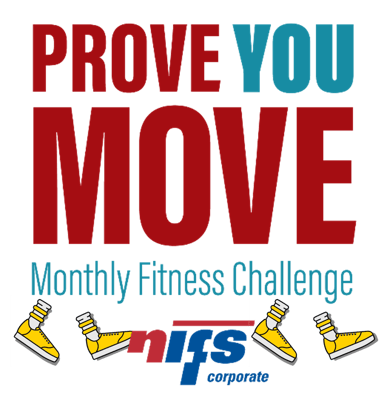 This month our corporate members are encouraged to pick a goal of 5,000 or 10,000 steps per day to kick of July’s Prove YOU Move Fitness Challenge. Some people cringe at the thought of 10,000 steps per day, but it isn’t just intentional exercise. Have you ever considered how many steps you actually take in a given day? How often are you moving throughout the office or your house? You might actually surprise yourself. Most phones have a Health App, or you can add a step tracker to your smart phone. If you keep your phone on your body throughout the day, it will calculate your movement and track your steps. As you start digging into your phone, don’t get down on yourself when you discover how little you possibly move, remember your phone must be on your body throughout the day to get the best estimate.
This month our corporate members are encouraged to pick a goal of 5,000 or 10,000 steps per day to kick of July’s Prove YOU Move Fitness Challenge. Some people cringe at the thought of 10,000 steps per day, but it isn’t just intentional exercise. Have you ever considered how many steps you actually take in a given day? How often are you moving throughout the office or your house? You might actually surprise yourself. Most phones have a Health App, or you can add a step tracker to your smart phone. If you keep your phone on your body throughout the day, it will calculate your movement and track your steps. As you start digging into your phone, don’t get down on yourself when you discover how little you possibly move, remember your phone must be on your body throughout the day to get the best estimate.
Increasing your daily step count and simply moving more by walking has many health benefits. Let’s take a closer look at why you should Prove YOU Move this month.
- Heart Health: Moving more of course improves heart health, but did you know it can decrease your risk of heart disease by 20%?
- No Gym Required: Moving your body by walking is FREE! No gym membership required. Step outside and go!
- Burn Calories: Many factors come into play like walking pace, distance, and your weight, but moving your body burns calories more than binge watching your favorite shows.
- Boost Your Mood: Stepping outside and taking in your surroundings helps get your mind off any negative thoughts or situations. Decrease stress in your day by walking.
- Tone Muscles: Walking is a great way to increase muscle tone. Choose a pace that makes your heart rate increase. Use your arms as you walk and get the most out of those steps. As you complete your walk, you may find you enjoy the lingering tingle in your muscles.
- Increase Energy: Walking helps increase oxygen flow in your body which helps increase cortisol and epinephrine levels that increase energy. You may not need so much coffee after all.
- Be Social: How often do you cross paths with a neighbor when out for a walk after dinner or a stranger when walking through the office. A simple hello and smile can not only boost your mood, but make your day or someone else’s simply by being kind.
How much should you move?
A general rule of thumb is 150 minutes of physical activity per week for adults; that is 30 minutes a day! There are about 2,000 steps in a mile, so if you can squeeze in 1.5 miles in 30 minutes you are almost to that 5,000 steps a day goal! Keep in mind that is only considering intentional movement. Here are other ways to increase steps throughout the day.
- Instead of scrolling social media during your lunch break, go for a walk after you eat. This can also help aid in digestion.
- Schedule that meeting as a walking meeting. Boost your creativity with your team by taking the meeting on foot.
- Park further away. Rather than taking that closer spot, park further away or higher up in the parking garage.
- No elevator needed, take the stairs!
- Kids have practice? Just say no to bleacher butt, walk around the field.
Eager to see where you stand in the daily step count? Head over to our NIFS Fitness Management Facebook Page and join us by sharing your step goal this month. We’d love to see how you move more this July! Tag us using @NIFSFitnessManagement and #NIFSProveYOUMove!


 I know... "purpose" for your employees sounds all New Age-y or like some wellness vendor ploy to not have to put up numbers for a client. But the truth is, there is quite a bit of science behind the health benefits of individuals living with a sense of purpose. In fact, scientists attribute better pain management, longevity, and slower rates of cognitive decline to a sense of purpose in adults. For an outline of some of the research-based findings of the benefits of purpose,
I know... "purpose" for your employees sounds all New Age-y or like some wellness vendor ploy to not have to put up numbers for a client. But the truth is, there is quite a bit of science behind the health benefits of individuals living with a sense of purpose. In fact, scientists attribute better pain management, longevity, and slower rates of cognitive decline to a sense of purpose in adults. For an outline of some of the research-based findings of the benefits of purpose, 
 Corporate fitness programs in businesses all across the country have been doing pretty much the same thing, quite possibly for decades. The programs look very different, one from the next, but the basic premise is the same.
Corporate fitness programs in businesses all across the country have been doing pretty much the same thing, quite possibly for decades. The programs look very different, one from the next, but the basic premise is the same.

 One of the ways they work on achieving specific participation numbers is through successful programming. It’s not rocket science, but you do have to know your members and understand what works with them in order to build effective programs. That’s why our crew is so focused on
One of the ways they work on achieving specific participation numbers is through successful programming. It’s not rocket science, but you do have to know your members and understand what works with them in order to build effective programs. That’s why our crew is so focused on  There’s a lot of misinformation out there on what is and is not good for you. The science changes all the time; unfortunately, changes in health information can
There’s a lot of misinformation out there on what is and is not good for you. The science changes all the time; unfortunately, changes in health information can 